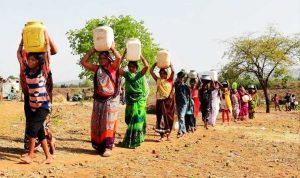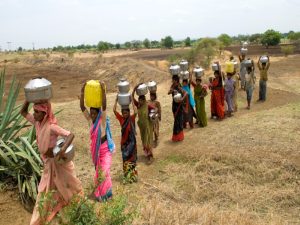Climate-change induced deficient rainfall, poor storage of rainwater and water-intensive agriculture are responsible

Photo courtesy: Dhakatimes
According to data released by the India Meteorological Department, the South-West monsoon during June- August 2023 has been below normal in 42 per cent of the districts (see Table). In August, rainfall in the country was 32 per cent below normal and in the southern States it was 62 per cent. In the last 122 years — that is, since 1901 — India received the lowest rainfall in August this year. With only about a month left for the end of the South-West monsoon, the reduced rainfall will not only affect agriculture severely but it could also lead to massive water shortages in different regions of the country. What should be done to prevent water shortage?
Although India has the largest water resources (irrigated area) in the world, water demand has been increasing rapidly due to rapid changes in agriculture and industrial activities in recent times. The net amount of water that can be used in our country in a year is estimated at 1,121 billion cubic meters (bcm). However, the data published by the Ministry of Water Resources shows that the total water demand will be 1,093 bcm in 2025 and 1,447 bcm in 2050. This means that there will be a major water shortage in India within 10 years.
However, this does not mean that there is no water shortage at present. As per the Falkenmark Water Index (which is mostly used for measuring water scarcity throughout the world), wherever the amount of water available per capita is below 1,700 cubic meters in a year, there is water scarcity. Going by this index, almost 76 per cent of people are already living with water scarcity in India.
In Tamil Nadu, which is one of the water-scarce States in terms of per capita availability, water demand was more than its supply even before 1990-91. For example, the total water requirement of Tamil Nadu was 31,458 million cubic meters (mcm) in 2004, but the supply was only 28,643 mcm. This means that Tamil Nadu has been experiencing water shortage for the last 30 years.
Deficit monsoon rainfall alone cannot be the cause of water scarcity. Various estimates show that after 1990-91, the water demand has been continuously increasing due to increased economic activities including the intensification of agriculture. However, no major plans have been made to develop new water sources and strengthen the storage capacity of existing water sources to match the ever-increasing demand for water.
Rivers, small water bodies (tanks and others) and domestic wells met the daily water requirements for many years. Due to poor maintenance of tanks and other small water bodies, water could not be stored adequately even in years of good rainfall. Data show that drought has occurred in India several times due to deficit rainfall. But recently, due to climate changes, rainy days are shrinking.
The Intergovernmental Panel on Climate Change (IPCC) has warned in its reports that the climate is changing rapidly which will result in reduced rainfall, both in number of days and quantum. Rainfall deficiency can lead to water scarcity, which will severely affect people’s lives, livestock, wildlife and others. Water scarcity can cause major environmental and economic problems. In the report, ‘Climate Change, Water and Economy’, the World Bank (2016) underlines that countries with water shortages may face a major setback in economic growth by 2050.
Photo courtesy: The Caravan
The remedies
Central Water Commission data show that the water storage level of 150 major reservoirs as of August 31 was 23 per cent less than last year’s storage level of 146.828 bcm. El Nino, which occurs due to global warming and often changes the rainfall pattern, is becoming the new normal in recent years. There is, therefore, the need to make tough decisions to avoid water scarcity. Everyone forgets the pain caused by water scarcity once the rainy season starts. This kind of mindset needs to change first.
As the total quantum of rainfall and the number of rainy days are shrinking due to climate change, more serious efforts should be made to store rainwater wherever possible. States like Andhra Pradesh, Karnataka, Tamil Nadu and Telangana cannot solve the water scarcity problem without rejuvenating tanks, as all these States have a large number of tanks. The Minor Irrigation Census shows that there are a total of 6.42 lakh tanks, lakes and ponds in India.
However, the Parliamentary Standing Committee on Water Resources has stated in its 16th report on ‘Repair, Renovation and Restoration of Water Bodies’ that most of the small water bodies are encroached upon by government and private bodies. The First Census of Water Bodies published by the Ministry of Water Resources in 2023 has found that 38,486 water bodies have been encroached upon in India. Tough measures are needed to remove the encroachments.
About 85 per cent of the utilisable water is currently used by the agricultural sector. This can be reduced by changing the cropping pattern. Appropriate minimum support policies need to be introduced to reduce the area under water-intensive crops such as paddy, sugarcane and banana. As per the MS Swaminathan committee report on ‘More Crop and Income Per Drop of Water’ (2006), drip and sprinkler irrigation can save around 50 per cent of water in crop cultivation and increase the yield of crops by 40-60 per cent. A total of about 70 million hectares are identified as potential areas for such micro-irrigation method. While making efforts to increase the area under micro-irrigation, farmers should be advised to use such water-saving methods for cultivating water-intensive crops in areas of severe water scarcity.
Water is no longer a public good; it is increasingly becoming an expensive commodity. With the changing pattern of rainfall, severe water shortages are likely to occur frequently in the future. A severe water shortage in 2018 in Cape Town, South Africa, forced the authorities there to ration the supply of water (25 litre/person/day), causing much hardship to the public. This may happen in India, too. Therefore, water should be stored wherever possible during the deficit rainfall period to prevent water poverty in the future.
Neerain is proud to republish this blog for spreading awareness about situation of water, for our stake holders. Credit whatsoever goes to the Author.
This blog is published by: –
https://www.thehindubusinessline.com/opinion/india-is-staring-at-water-poverty/article67282233.ece
We would like to spread this for the benefit of fellow Indians.
Author: Narayanamoorthy
Publish On: 07 , September , 2023

